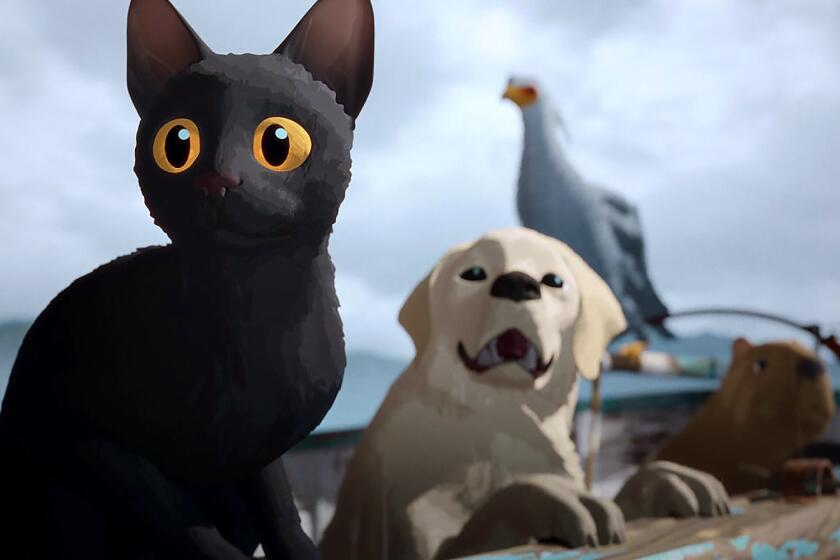Fairy tales for a mean new world
IT’S kiddie season at the movies, and children are everywhere you look: brandishing machine guns in “Blood Diamond,” fighting for their lives in the desert in “Babel,” suffering from mortal wounds in “Pan’s Labyrinth,” being blown to bits in “Deja Vu,” sleeping in public toilets in “The Pursuit of Happyness” and getting massacred in “The Nativity Story.”
Hollywood historically has steered away from depicting children in peril, typically limiting any life-or-death struggles to cartoonishly violent genre films such as “The Shining,” “Aliens” and “Terminator 2: Judgment Day.” But as this new batch of movies underscores, the old rules of childhood engagement are rapidly evolving. Instead of consigning children to the periphery of horrific realities, these films are dragging kids -- preteens to toddlers -- right into the middle of the mayhem.
In a way, the movies are reworking the troubling narratives laid out ages ago in the works of the Brothers Grimm, Hans Christian Andersen and Charles Dickens. And like those authors, some of the filmmakers are using children to make political points. Others find that putting children into jeopardy gives their dramas more of an emotional wallop.
But even for a generation of viewers desensitized by a 24/7 stream of broadband brutality from sources as divergent as the Iraq war and the Ultimate Fighting Championship, some of these movie scenes may prove difficult to stomach.
“These are not your father’s fairy tales,” says Guillermo del Toro, the writer-director of “Pan’s Labyrinth,” whose opening shot features an 11-year-old girl apparently dying from a gunshot wound.
Catherine Hardwicke, director of “The Nativity Story,” made the decision to depict, rather than just allude to, King Herod’s biblical Massacre of the Innocents in her film, with 2-year-olds being dragged to their deaths.
“I think people now are going for a much more realistic, authentic approach,” says Hardwicke. “You don’t want to leave out things that add to the realism and take you into the moment.”
Some of the most troubling imperiled kid scenarios unfold in “Babel,” a drama featuring four seemingly unrelated but ultimately intersecting stories. In one, two small American children are abandoned in the desert with their nanny but no food or water; in another, two young Moroccan brothers shoot a rifle with catastrophic results.
“I wrote ‘Babel’ from the point of view of a father, and the pain that you feel when something goes wrong with your kid,” says the film’s screenwriter, Guillermo Arriaga. “The world is turning more and more individualistic, and solidarity is starting to break down between human beings. And children are the ones who are suffering the most. They don’t have a way to defend themselves. They are in this world without asking how they came into it.”
Rather than concoct stories for shock value, Arriaga says some of the incidents involving “Babel’s” children are directly drawn from real events. Mexican children as young as 6 months old, he says, are abandoned on the border and left to fend for themselves. “Of course it’s terrifying. Of course it’s horrifying,” says the screenwriter, from Mexico City. “But it happens.
“Art has to begin to address the world’s problems. And we cannot be shy of presenting problems because we are afraid of scaring the audience. There is an audience willing to see what’s truly going on in the world, and closing our eyes will not help solve the problems.”
Mirroring events
REAL-LIFE depictions of children in dire circumstances turn up in several other movies. At the center of the Dec. 8 release “Blood Diamond” stands a drama about an African diamond smuggler (Leonardo DiCaprio) battling his conscience. But the movie also focuses on Sierra Leone’s civil war, in which children were taken from their families and forced into battle, where they killed other children.
“The Pursuit of Happyness” (which hits theaters Dec. 15) tells the real-life story of Christopher Gardner, a struggling San Francisco salesman of medical equipment who became homeless. While living on the streets, Gardner (Will Smith) labors to complete a stockbroker internship and care for his young son (Smith’s own child, Jaden). In one of the movie’s most heartbreaking sequences, Gardner can’t find anywhere to sleep and must repair to a public bathroom, where he fashions a bed for his young son out of toilet paper.
“The movie is about how much the father can do to take all the pain,” “Happyness” director Gabriele Muccino says. “When you have a child, everything becomes way more dramatic. You have to protect his integrity, save him from being affected by trauma. And you have to forget how much pain you’re going through to be able to prevent a child’s pain.”
Still, not every filmmaker shares the director’s protective attitude toward children. Case in point: Terry Gilliam, whose Gothic fantasy “Tideland” follows the plight of 10-year-old Jeliza-Rose (Jodelle Ferland) after the back-to-back drug overdose deaths of her junkie parents. A paranoid taxidermist, a lobotomized epileptic and a bunch of talking headless dolls vie for her attention in the film’s creepy, pastoral Wonderland.
Although the Motion Picture Assn. of America gave the film an R rating for what it describes as “bizarre and disturbing content, including drug use, sexuality and gruesome situations -- all involving a child ...,” Gilliam insists Jeliza-Rose is never in peril. Moreover, he dismisses the notion that children are any more deserving of sympathetic treatment in films than adults.
“We seem to be trapped in a lot of middle-aged people’s idea of what a child is,” Gilliam says. “That usually means some delicate little creature who’s a victim and who needs care constantly. I think that’s nonsense.”
He adds: “They’re much less vulnerable in many ways than adults. They are tough little creatures. I find it shocking that people don’t want to believe that.”
Del Toro, the writer-director of the alternately tragic and magical “Pan’s Labyrinth,” shares Gilliam’s perspective. When he was putting together his first film, 1997’s “Mimic,” he was warned by a marketing executive that the two things he couldn’t do in an American movie were to kill dogs and children. He immediately added a scene in which one dog and two children die.
Ofelia (Ivana Baquero), the young protagonist at the center of “Pan’s Labyrinth,” is as determined and independent as the adults around her. “She comes to a crossroads in her life,” Del Toro says. “She has to choose between continuing to have a fantasy world and being a nicely dressed little lady.” At the same time, he says, “she is basically an innocent being manipulated by everyone around her.”
Those manipulations quickly lead Ofelia into danger. “Many fairy tales, especially the harsher ones of Hans Christian Andersen and Oscar Wilde and the Brothers Grimm, have a fair amount of tragedy for children. I think children are and always have been central to the drama of the fantasy genre. And we can’t sanitize that -- the magical value of the story doesn’t mean anything without darkness.”
But on hearing descriptions of the upcoming films, David Walsh, president of the National Institute on Media and the Family, worries that focusing on children in peril could amplify fears in a society that ha
s already circled its wagons around the young. “The impact of this stream of movies will be to accentuate the ‘mean world syndrome,’ making parents and kids think that the world is a hostile place,” says Walsh. “There is a real downside to that. As we get more protective of kids, we shield them from many important experiences -- as we hover over them in protection, we’re robbing them of opportunities to solve their own problems.”
A specter of suffering
IT was the link between fear and overprotectiveness that intrigued writer-director Todd Field when he adapted Tom Perrotta’s novel “Little Children.” He found that the book’s darkest plot twists about children -- particularly a surprise revelation about a young girl’s disappearance -- actually detracted from the narrative, and he wanted to explore how fear of violence, rather than the actual violence, against children shaped behavior.
“The curse of being a parent is that you live in a constant state of anxiety, that something bad will happen to your child,” Field says. “And that fear can be more powerful when it’s presented theatrically.”
So rather than focus on the sexually predatory acts of the character Ronald James McGorvey as laid out in Perrotta’s novel, Field shifted his film’s emphasis to how McGorvey’s neighbors and mother interact with him. The film’s characters aren’t just apprehensive about their children. There’s also a reference to “homeland security,” and the more one character tries to make the neighborhood safe, the more trouble he churns up. “Fear and paranoia interests me,” says Field.
In one incident central to the book as well as the film, McGorvey goes swimming at a public pool, creating the kind of panic you might associate with an approaching tsunami. Once he’s removed, the swimmers are elated. “That is the disturbing part of the scene to me,” Field says. “How they react when the fear is gone -- about how people react in such an extreme fashion.”
In the sci-fi drama “Deja Vu,” a domestic terrorist loads a New Orleans passenger ferry with hundreds of pounds of explosives. When the film opens, crowds of people pile into the doomed boat, and director Tony Scott offers several close-ups of children on a school outing. According to Bill Marsilii, who wrote the film’s script with Terry Rossio, the idea was to make the crime so hideous that the time-traveling efforts of a federal agent Doug Carlin (Denzel Washington) to prevent the bombing take on a level of urgency that lasts until the end of the movie.
“At one point, Tony was pushing strongly for the boat to only have servicemen on it,” Marsilii says. “Terry and I felt that for the rest of the movie to have the emotional weight it needed, there had to be innocents onboard.”
He adds: “It’s easy to goose a reaction from an audience by killing kids. But none of the choices that went into creating the opening were done blithely. I don’t think I could ever start a movie with the death of that many children on-screen unless the whole rest of the movie was about trying to undo it.”
Hardwicke sees her “Nativity” -- and its scenes of infanticide -- in part as a correction to the films that have preceded it.
“You look at historical epics of the past and everyone is white, clean and movie-star looking. I don’t think that’s what audiences want and [it] isn’t what filmmakers are doing anymore,” says Hardwicke, who explored teen sexuality in 2003’s “Thirteen.”
“We’re trying to transport you to another place and make you feel the dirt under the fingernails. We wanted you to feel that horror because that was part of the horror of the time.”
john.horn@latimes.com, chris.lee@latimes.com
More to Read
Only good movies
Get the Indie Focus newsletter, Mark Olsen's weekly guide to the world of cinema.
You may occasionally receive promotional content from the Los Angeles Times.












